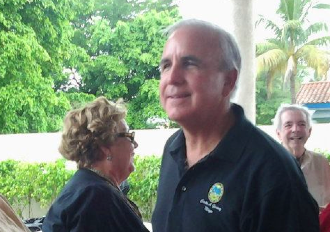(Continued from previous page)
He is particularly perplexed by the Gimenez doubletalk on the proprietary funds, which are departments that make money and whose budgets are separate from the general fund, like Water and Sewer. As a commissioner, Gimenez said they should be treated separately. But now as mayor, that is not what he is doing.
“He’s always demanding more from the proprietary funds so he can subsidize the rest of the budget,” Azoy told Ladra. “Water and sewer has no deficit. We have so much money in our department, so much liquidity, that our bond rating is the highest.”

Azoy said that his department proposed saving money by cutting all the projects and designs that go to outside consultants and contractors — for a higher price — and could be handled in-house for less. One example, he said, was a job on a diesel tank at one of the plants, which has to be coated and maintained so that it doesn’t contaminate the ground underneath. A bid came in for $150,000 but the department was able to complete the job for $47,000. Afterwards, the same job at the Alexander Orr plant on Southwest 87th Avenue went to an outside contractor, Azoy said. Price: About $200,000. (More on that later).
“Millions of dollars are going to waste and that has to be corruption,” Azoy said, adding that he has filed countless of grievances and class action suits because the county does not adhere to its gain sharing agreement, where the department gets first dibs on projects.
“There’s no other explanation.”
Related story: Cash-strapped Miami-Dade considers $1 lease on 4-acre site
Azoy, like other union leaders, said he has lost faith in the numbers because they move around so much, with a shortfall that has dropped — like the orange at Bayfront Park on New Year’s Eve — from $208 million to $64 million in six weeks.
“The bottom line is, you don’t come to the table with bogus numbers. You come with the truth and work from that,” Azoy said.
 Andy Madtes, president of the AFSCME union that represents the largest number of county workers, said he was also frustrated with the changing numbers as they tried to put together a proposal that makes sense.
Andy Madtes, president of the AFSCME union that represents the largest number of county workers, said he was also frustrated with the changing numbers as they tried to put together a proposal that makes sense.
Madtes proposed the committee of labor leaders and administrators that are reviewing healthcare options to save money. He said that one of the problems is that the county has had the same provider for eight years and he wants to open it up to bids.
“The goal of the committee was not to negotiate terms. The goal was to find savings,” he said. “Now, all he wants to do is take more from workers, cut benefits.”
According to figures from the budget office, cited in the Miami Herald story, healthcare benefit reductions would result in a savings of $50 million but only close the shortfall to a tune of $18 million because it is in the county’s general fund, which is about $1.5 billion of the total $4.4 billion budget.
So, what happens to the other $32 million? The Herald didn’t say, and the mayor’s letter to unions doesn’t address it and Ladra didn’t get immediate answers to her questions, sent to the mayor’s office at 10:15 a.m. Wednesday.
And it’s almost midnight.
Seems like they are some pretty easy questions too:
- Why is the mayor lumping proprietary funds like water and sewer in with the other unions if they are in the black?
- What has been his response to the millions in savings that department heads have recommended?
- Can he speak to Azoy’s claims that there is wasteful spending on consultants and outside work that could be done much less expensively in-house?
- Is he not honoring the “gain-sharing program” that would allow the water and sewer department to compete in the bid process?
- Why did the county go from an administered plan, where all the risk was with the provider, to a self-insured plan, where all the risk is here at home?
- And how much did that save?
- What did the actuarial reports say about the risks?
- When did the furloughs start and how much does that save?
Okay, that last one may be a little harder to remember without going back and finding the document.
I’ll let you all know when I get the answers.

